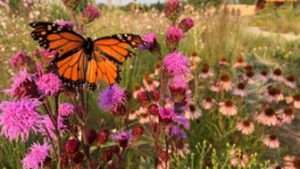Pollination Syndromes

Flowers have evolved into a dizzying array of shapes, sizes, colors, and arrangements since first making waves on the evolutionary scene at least 120 million years ago. In most cases, this huge spread of morphology owes its existence to the interaction between pollinators and plants. The more effectively a given animal pollinates a plant, the more that plant species will, over time, adapt to favor pollination by that animal.
These adaptations are predictable by pollinator type, and are sometimes referred to as “pollination syndromes.” If looking to attract a specific type of insect or another animal to your garden, having a general understanding of these syndromes can be both fun and useful when shopping at the nursery.
First to evolve, and perhaps least flashy, beetle-pollinated flowers bear cup shapes (think magnolia) and are generally creamy or white in color with varying degrees of scent. These cup-shaped crash pads provide an easy place to land and a high-protein meal in the form of pollen for beetles, which can be a bit awkward in flight.
With adept vision and attunement for colors (except for red, which they do not perceive), bees benefit from “nectar guides” — lines or dots leading to the flower’s nectar. Flowers adapted for pollination by bees typically present in yellows, purple, blue, or white, and bear a flat area that acts as a landing pad. Bee-pollinated flowers typically have some pollen available, which is a high-protein food source for these hardworking insects. Interestingly, because bees can perceive ultraviolet radiation, many flowers have evolved features designed to show up under the UV light emitted by the sun. These features are invisible to our naked eyes but can be seen under a UV lens. Commonly grown bee-pollinated species in our region include sunflowers (Helianthus spp.), asters (Symphyotrichum spp.), and lavender (Lavandula spp.).
Butterfly-pollinated flowers share a few features with bee-pollinated flowers: nectar guides are common, landing pads are typical, scents are mild and sweet, and colors are vivid. Beyond these similarities, butterfly-pollinated flowers produce abundant nectar that is at the end of a tube – a long and nimble proboscis is almost always required. For local examples, look to butterfly bush (Buddleja spp.), liatris (Liatris spp.) and phlox (Phlox spp.).
Proportioned quite a bit like butterfly-pollinated flowers, bird-pollinated plants feature flowers with long and tube-like shapes. This is especially true for New World plants where long-beaked hummingbirds are a primary bird pollinator. These plants will often bear sturdy stems to accommodate occasional use as a perch, too. Native plants pollinated by birds are often bright red or orange, like Penstemon eatonii and hummingbird mint (Agastache rupestris), since these hot colors make them easy for visually navigating hummingbirds to see from a distance.
A variety of other animals, including bats, moths, and flies also reliably pollinate plants. Their pollinator syndromes, however, can make them less appealing to gardeners: bat and moth pollinated flowers are typically white and night-blooming since these pollinators are generally nocturnal, and fly pollinated flowers are generally designed to mimic an animal carcass, complete with a smell. So, next time you’re at the nursery, consider what animals your plant choices may attract. Just be sure whatever way you decide to “flesh out” the front border appeals to you, too.
We are here to share current happenings in the bee industry. Bee Culture gathers and shares articles published by outside sources. For more information about this specific article, please visit the original publish source: Pollination Syndromes (northfortynews.com)






